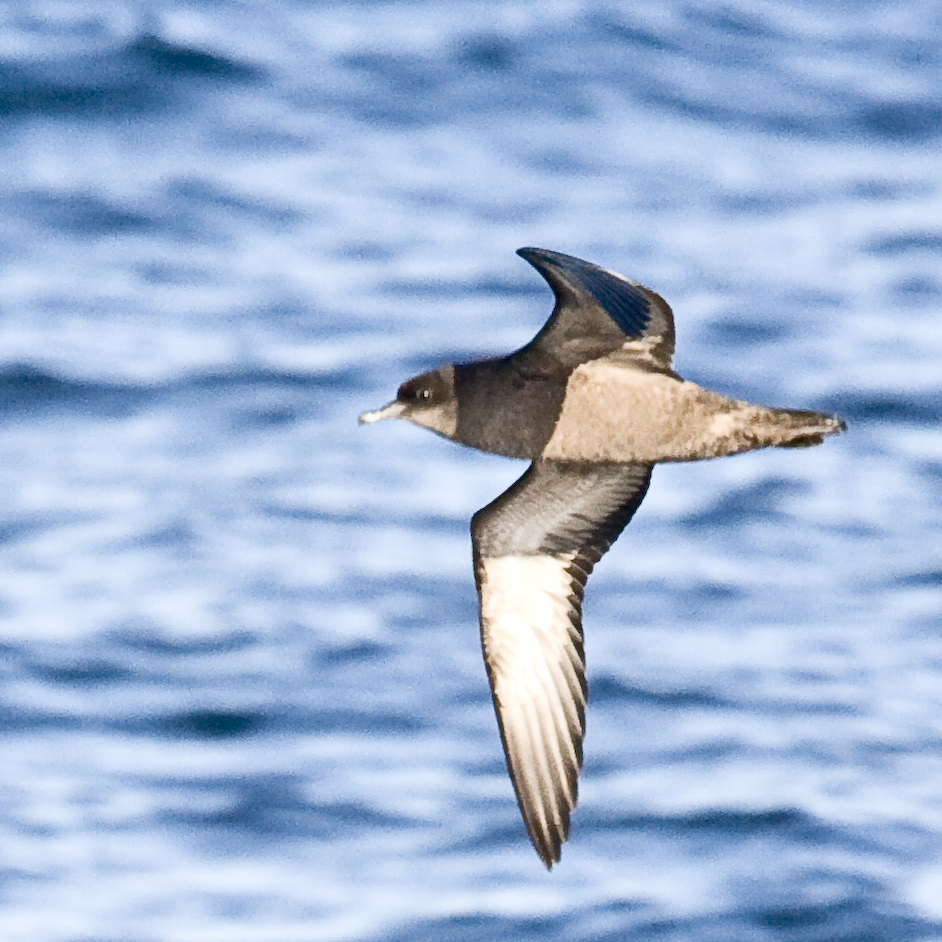- Short-tailed Shearwater
Taxobox
name = Short-tailed Shearwater
status = LC | status_system = IUCN3.1

regnum =Animal ia
phylum = Chordata
classis = Aves
ordo =Procellariiformes
familia =Procellariidae
genus = "Puffinus "
species = "P. tenuirostris
binomial = "Puffinus tenuirostris"
binomial_authority = (Temminck, 1835)The Short-tailed Shearwater "Puffinus tenuirostris", or Yolla, more commonly known as the
muttonbird inAustralia , is the most abundantseabird species in Australian waters, and is one of the few Australian native birds that is commercially harvested. It is a migratory species that breeds mainly on small islands inBass Strait andTasmania and migrates to theNorthern Hemisphere for the boreal summer. It is worth noting that inNew Zealand theSooty Shearwater is the local 'muttonbird', and other harvested petrel species, such as theWedge-tailed Shearwater , may be known as muttonbirds elsewhere.This species appears to be related to the New Zealand muttonbird and the
Great Shearwater , all blunt-tailed, black-billed species, but its precise relationships are obscure (Austin, 1996; Austin "et al"., 2004). These are among the larger species of shearwater which might belong into a separate genus, "Ardenna" (Penhallurick & Wink, 2004).Each parent feeds the single chick for 2–3 days and then leaves for up to three weeks in search of food. These foraging trips can cover a distance of 15,000 km (9,300 mi) and mean the chick may be left unattended for over a week. When the chicks fledge they weigh around 900 g (2 lb), and may be heavier than their parents. In Tasmania, and especially on the muttonbird islands of the
Furneaux Group , the chicks are harvested at this time for food and oil.Each austral winter, the Shearwaters migrate to the seas off the
Aleutian Islands andKamchatka . In the austral spring, they travel down the coast ofCalifornia before crossing thePacific back to Australia.References
* Austin, Jeremy J. (1996): Molecular Phylogenetics of "Puffinus" Shearwaters: Preliminary Evidence from Mitochondrial Cytochrome "b" Gene Sequences. "Molecular Phylogenetics and Evolution" 6(1): 77–88. DOI|10.1006/mpev.1996.0060 (HTML abstract)
* Austin, Jeremy J.; Bretagnolle, Vincent & Pasquet, Eric (2004): A global molecular phylogeny of the small "Puffinus" shearwaters and implications for systematics of the Little-Audubon's Shearwater complex. "Auk" 121(3): 847–864. DOI: 10.1642/0004-8038(2004)121 [0847:AGMPOT] 2.0.CO;2 [http://www.bioone.org/perlserv/?request=get-abstract&doi=10.1642%2F0004-8038%282004%29121%5B0847%3AAGMPOT%5D2.0.CO%3B2 HTML abstract]
* Database entry includes justification for why this species is of least concern
* Penhallurick, John & Wink, Michael (2004): Analysis of the taxonomy and nomenclature of the Procellariformes based on complete nucleotide sequences of the mitochondrial cytochrome "b" gene. "Emu" 104(2): 125-147. DOI|10.1071/MU01060 (HTML abstract)
Further reading
Identification
Gillson, Greg (2008) Field separation of Sooty and Short-tailed Shearwaters off the west coast of North America "Birding" 40(2):34-40
External links
*Parks & Wildlife Service Tasmania: [http://www.parks.tas.gov.au/wildlife/birds/muttbird.html Birds of Tasmania: Short-Tailed Shearwater, "Puffinus tenuirostris"]
*Port Fairy website: [http://www.port-fairy.com/shearwaters.htm Griffiths Island Shearwater Colony]
Wikimedia Foundation. 2010.
